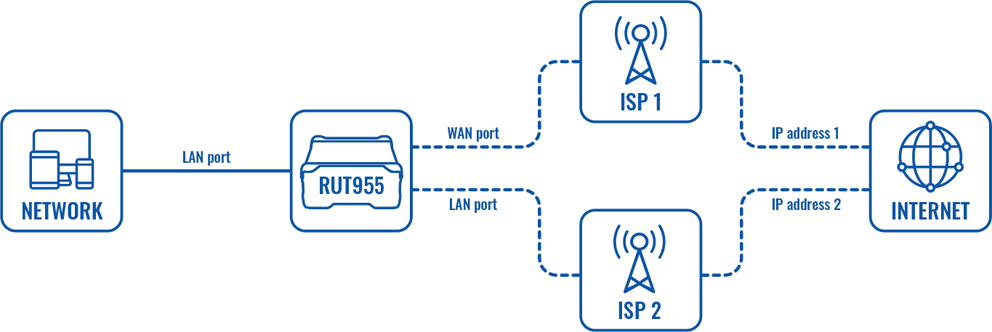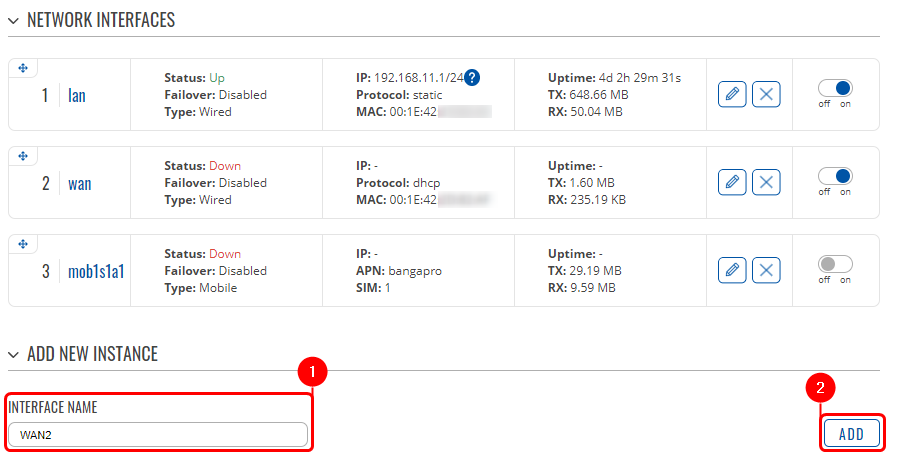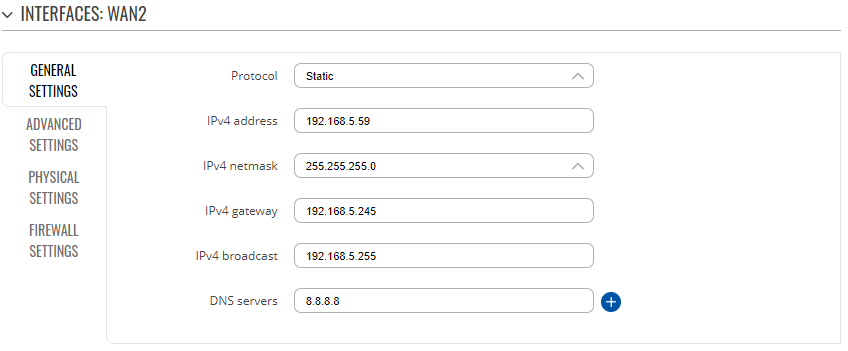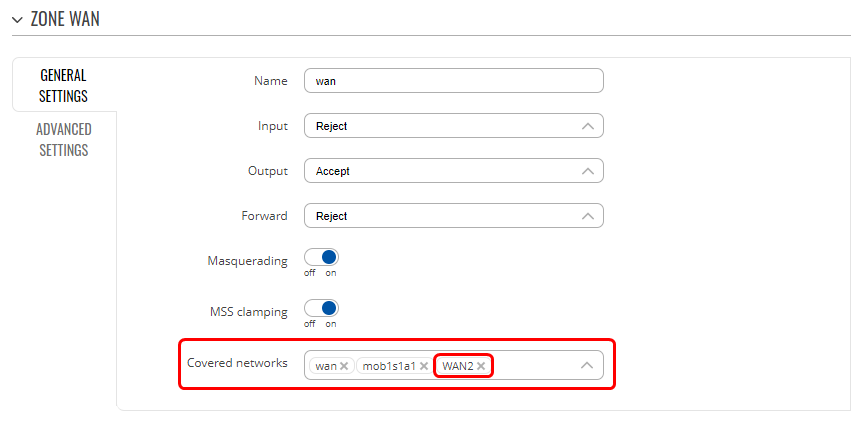Difference between revisions of "LAN as WAN RutOS"
PauliusRug (talk | contribs) |
|||
| (7 intermediate revisions by 3 users not shown) | |||
| Line 1: | Line 1: | ||
| − | + | <p style="color:red">The information on this page is updated in accordance with the [https://wiki.teltonika-networks.com/view/FW_%26_SDK_Downloads'''00.07.4'''] firmware version .</p> | |
==Introduction== | ==Introduction== | ||
| Line 31: | Line 31: | ||
* On newly created VLAN ID (3 in this example), from drop-down list, select <strong>Untagged</strong>, on same port. | * On newly created VLAN ID (3 in this example), from drop-down list, select <strong>Untagged</strong>, on same port. | ||
* After performing these actions press <strong>Save & Apply</strong> in VLAN settings. | * After performing these actions press <strong>Save & Apply</strong> in VLAN settings. | ||
| − | [[File: | + | [[File:VLAN config.png|border|center|class=tlt-border|798x239px]] |
| − | |||
===Add new WAN interface=== | ===Add new WAN interface=== | ||
---- | ---- | ||
| Line 39: | Line 38: | ||
* Enter new <strong>Interface Name</strong>. | * Enter new <strong>Interface Name</strong>. | ||
* Click on <strong>Add</strong> button. | * Click on <strong>Add</strong> button. | ||
| − | [[File: | + | [[File:New interface.png|border|center|class=tlt-border|901x453px]] |
---- | ---- | ||
| Line 45: | Line 44: | ||
* Choose <strong>DHCP</strong> Protocol from drop-down list. | * Choose <strong>DHCP</strong> Protocol from drop-down list. | ||
* Press on <strong>Switch Protocol</strong>. | * Press on <strong>Switch Protocol</strong>. | ||
| − | [[File: | + | [[File:DHCP settings.png|border|center|class=tlt-border|870x261px]] |
If there is need to use a '''static IP''' instead of '''DHCP option''' select '''Static''' option and specify: | If there is need to use a '''static IP''' instead of '''DHCP option''' select '''Static''' option and specify: | ||
* IPv4 address | * IPv4 address | ||
| Line 52: | Line 51: | ||
* IPv4 broadcast | * IPv4 broadcast | ||
* DNS servers | * DNS servers | ||
| − | [[File: | + | [[File:Static IP.png|border|center|class=tlt-border|848x351px]] |
---- | ---- | ||
After switching protocol More setting options will appear. | After switching protocol More setting options will appear. | ||
* Go to <strong>Physical Settings</strong>. | * Go to <strong>Physical Settings</strong>. | ||
| − | * From drop-down list choose previously created VLAN interface (in this example it is eth0. | + | * From drop-down list choose previously created VLAN interface (in this example it is eth0.3) |
* Press <strong>Apply & Save</strong>. | * Press <strong>Apply & Save</strong>. | ||
| − | [[File: | + | [[File:Physical interface.png|border|center|class=tlt-border|866x281px]] |
===Set/Check Firewall=== | ===Set/Check Firewall=== | ||
| Line 65: | Line 64: | ||
Go to <strong>Network > Firewall > General Settings</strong> WebUI section. Click on Edit button on WAN zone. | Go to <strong>Network > Firewall > General Settings</strong> WebUI section. Click on Edit button on WAN zone. | ||
| − | |||
| − | |||
In WAN zone settings | In WAN zone settings | ||
* Make sure that yours newly created interface is selected in Covered networks list. | * Make sure that yours newly created interface is selected in Covered networks list. | ||
* Click Save & Apply. | * Click Save & Apply. | ||
| − | [[File: | + | [[File:Firewall zones.png|border|center|class=tlt-border|859x422px]] |
==Check new WAN interface== | ==Check new WAN interface== | ||
| Line 77: | Line 74: | ||
Insert WAN cable in selected port, go to <strong>Network > Interfaces</strong> WebUI section and if you followed steps correctly yours newly created WAN interface should be running and have an IP. | Insert WAN cable in selected port, go to <strong>Network > Interfaces</strong> WebUI section and if you followed steps correctly yours newly created WAN interface should be running and have an IP. | ||
[[File:Network rutos manual lan as wan check.png|border|class=tlt-border]] | [[File:Network rutos manual lan as wan check.png|border|class=tlt-border]] | ||
| + | |||
| + | ==Testing the configuration== | ||
| + | |||
| + | Your device should now have two wired WAN connections. | ||
| + | |||
| + | <ul> | ||
| + | <li>Set the Wired (WAN) interface as the main WAN connection.</li> | ||
| + | <li>Set the new interface as WAN [[RUT955_Failover|failover]] and save the changes. | ||
| + | <li>Go to [www.whatsmyip.com] and check your public IP address.<br></li> | ||
| + | <li>Then unplug the main WAN cable and check again. If the interface failed over correctly, the website should show a different IP address than before.<br></li> | ||
| + | <li>Plug the main WAN cable back in and wait a bit. Refresh the website; the IP should have change back to the one shown in the first place.</li> | ||
| + | </ul> | ||
| + | [[Category:LAN]] | ||
| + | [[Category:Update | hidden=yes]] | ||
Latest revision as of 16:28, 4 October 2023
Main Page > General Information > Configuration Examples > LAN > LAN as WAN RutOSThe information on this page is updated in accordance with the 00.07.4 firmware version .
Introduction
This article contains instructions on how to set up LAN port as WAN on RUTxxx if you have a need for multiple wired WAN connections.
Configuration overview and prerequisites
Before we begin, let's overview the configuration that we are attempting to achieve and the prerequisites that make it possible.
Prerequisites:
- One RUTxxx series router.
- At least two wired Internet connections.
- An end device for test the configuration.
Configuration scheme:
Setting up second WAN interface
To change LAN port purpose to WAN you will have to perform changes in 3 different locations of RUTxxx WebUI
Creating additional VLAN
Go to Network > VLAN section in device WebUI and perform following actions:
- Create new VLAN ID by clicking ADD button.
- On VLAN ID: 1 (LAN interface), select Off from drop-down list, on port that you want to use as secondary WAN.
- On newly created VLAN ID (3 in this example), from drop-down list, select Untagged, on same port.
- After performing these actions press Save & Apply in VLAN settings.
Add new WAN interface
Go to Network > Interfaces WebUI section.
- Enter new Interface Name.
- Click on Add button.
After doing that you will be redirected to new window to set up new interface, when there:
- Choose DHCP Protocol from drop-down list.
- Press on Switch Protocol.
If there is need to use a static IP instead of DHCP option select Static option and specify:
- IPv4 address
- IPv4 netmask
- IPv4 gateway
- IPv4 broadcast
- DNS servers
After switching protocol More setting options will appear.
- Go to Physical Settings.
- From drop-down list choose previously created VLAN interface (in this example it is eth0.3)
- Press Apply & Save.
Set/Check Firewall
Go to Network > Firewall > General Settings WebUI section. Click on Edit button on WAN zone.
In WAN zone settings
- Make sure that yours newly created interface is selected in Covered networks list.
- Click Save & Apply.
Check new WAN interface
Insert WAN cable in selected port, go to Network > Interfaces WebUI section and if you followed steps correctly yours newly created WAN interface should be running and have an IP.

Testing the configuration
Your device should now have two wired WAN connections.
- Set the Wired (WAN) interface as the main WAN connection.
- Set the new interface as WAN failover and save the changes.
- Go to [www.whatsmyip.com] and check your public IP address.
- Then unplug the main WAN cable and check again. If the interface failed over correctly, the website should show a different IP address than before.
- Plug the main WAN cable back in and wait a bit. Refresh the website; the IP should have change back to the one shown in the first place.







